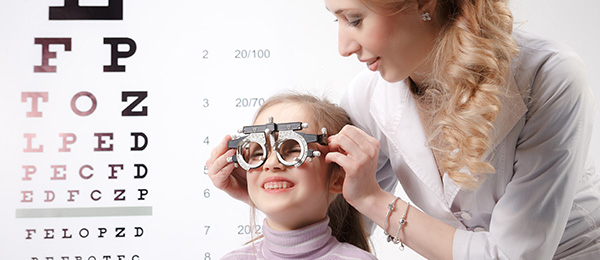NeoVision Provides Amblyopia / Lazy Eye Treatment
Definition of Amblyopia
Amblyopia is poor vision in an eye that did not develop normal sight during early childhood. It is sometimes called “lazy eye.” When one eye develops good vision while the other does not, the eye with poorer vision is called amblyopic. Usually, only one eye is affected by amblyopia, but it is possible for both eyes to be “lazy.”
Incidence of Amblyopia
Amblyopia is common, affecting approximately 2-3 out of every 100 people. The best time to correct amblyopia is during infancy or early childhood. People with amblyopia in one eye are more than twice as likely to lose vision in the healthy eye from trauma.
Development of Normal Vision
Newborn infants are able to see, but as they use their eyes during the first months of life, vision improves. During early childhood years, the visual system changes quickly and vision continues to develop. If a child cannot use his or her eyes normally, vision does not develop properly and may even decrease. After the first nine years of life, the visual system is usually fully developed and usually cannot be changed. The development of equal vision in both eyes is necessary for normal vision.
Causes of Amblyopia
A newborn cannot properly focus on an object at birth. Babies must learn to focus both eyes in the same way that they learn to control their motor skills. If a child is incapable of focusing both eyes, they will experience double vision. This is frustrating; consequently, they will learn to rely on only one eye for vision. Prolonged use of only one eye deteriorates the nerves to the unused eye, resulting in a condition called amblyopia, which is often called a lazy eye. Amblyopia has three major causes.
- Strabismus (Misaligned Eyes): Amblyopia occurs most commonly with misaligned or crossed eyes. The crossed eye “turns off” to avoid double vision and the child uses only the better eye. The misaligned eye then fails to develop good vision.
- Unequal Focus (Refractive Error): Amblyopia occurs when one eye is more near-sighted, far-sighted, or astigmatic compared to the other. This condition is called anisometropia. The unfocused (blurred) eye “turns off” and becomes amblyopic. The eyes can look normal but one eye has poor vision. This is the most difficult type of amblyopia to detect since the child appears to have normal vision when both eyes are open.
- Cloudiness in Lens / Droopy Eyelid: An eye disease such as cataract (a clouding of the naturally clear lens of the eye) may lead to amblyopia. Any factor that prevents a clear image from being focused inside the eye can lead to the development of amblyopia in a child. A droopy eyelid covering the pupil in a child may lead to amblyopia.
Diagnosis of Amblyopia
It is not easy to recognize amblyopia. A child may not be aware of having one strong eye and one weak eye. Unless the child has a misaligned eye or other obvious abnormality, there is no way for parents to tell that something is wrong. Amblyopia is detected by finding a difference in vision between the two eyes. Since it is difficult to measure vision in young children, your ophthalmologist often estimates visual acuity by watching how well a baby follows objects with one eye when the other eye is covered.
Using a variety of tests, the ophthalmologist observes the reactions of the baby when one eye is covered. If one eye is amblyopic and the good eye is covered, the baby may attempt to look around the patch, try to pull it off or cry.
Poor vision in one eye does not always mean that a child has amblyopia. Vision can often be improved by prescribing glasses for a child. Your ophthalmologist will also examine the interior of the eye to see if other eye diseases may be causing decreased vision. These diseases include cataracts, inflammations, tumors, and other disorders of the inner eye.
Treatment of Amblyopia
To correct amblyopia, a child must be made to use the weak eye. First, glasses are prescribed to correct any errors in focusing. If glasses alone do not improve vision, then patching is necessary. This is usually done by patching or covering the strong eye, often for weeks or months. Even after vision has been restored in the weak eye, part-time patching may be required over a period of years to maintain the improvement. If amblyopia is not treated, several problems may occur:
- The amblyopic eye may develop a serious and permanent visual defect
- Depth perception (seeing in three dimensions) may be lost
- If the good eye becomes diseased or injured, a lifetime of poor vision may be the result
Your ophthalmologist can give you instructions on how to treat amblyopia and can help you and your child to carry out this treatment. Children do not like to have their eyes patched. But as a parent, you must convince your child to do what is best for him or her. Your interest and involvement will be necessary for successful treatment.
Success in the treatment of amblyopia also depends upon (1) how severe the amblyopia is; (2) how old the child is when treatment is begun. If the problem is detected and treated early, vision can improve for most children. Amblyopia caused by strabismus or unequal refractive errors may be treated successfully during the first nine years of age. If amblyopia is not detected until early childhood, treatment may not be successful.
If you are concerned about your child’s vision and would like to schedule an eye appointment with NeoVision Eye Center, please contact us at 510-431-5511 (Union City). Remember! Early detection of amblyopia is the most important factor in determining if you can be treated effectively.

